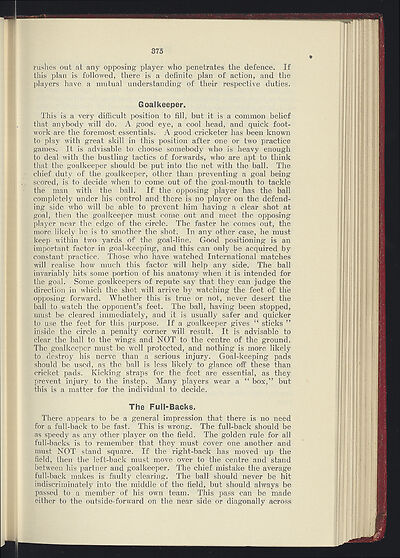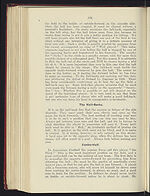1931
(389)
Download files
Complete book:
Individual page:
Thumbnail gallery: Grid view | List view

375
rushes out at any opposing player who penetrates the defence. If
this plan is followed, there is a definite plan of action, and the
players have a mutual understanding of their respective duties.
Goalkeeper.
This is a very difficult position to fill, but it is a common belief
that anybody will do. A good eye, a cool head, and quick foot-
work are the foremost essentials. A good cricketer has been known
to play with great skill in this position after one or two practice
games. It is advisable to choose somebody who is heavy enough
to deal with the bustling tactics of forwards, who are apt to think
that the goalkeeper should be put into the net with the ball. The
chief duty of the goall�eeper, other than preventing a goal being
scored, is to decide when to come out of the goal-mouth to tackle
the man with the ball. If the opposing player has the ball
completely under his control and there is no player on the defend-
ing side who will be able to prevent him having a clear shot at
goal, then the goalkeeper must come out and meet the opposing
player near the edge of the circle. The faster he comes out, the
more likely he is to smother the shot. In any other case, he must
keep within two yards of the goal-line. Good positioning is an
important factor in goal-keeping, and this can only be acquired by
constant practice. Those who have watched International matches
will realise how much this factor will help any side. The ball
invariably hits some portion of his anatomy when it is intended for
the goal. Some goalkeepers of repute say that they can judge the
direction in which the shot will arrive by watching the feet of the
opposing forward. Whether this is true or not, never desert the
ball to watch the opponent's feet. The ball, having been stopped,
must be cleared immediately, and it is usually safer and quicker
to use the feet for this purpose. If a goalkeeper gives " sticks "
inside the circle a penalty corner will result. It is advisable to
clear the ball to the wings and NOT to the centre of the ground.
The goalkeeper must be well protected, and nothing is more likely
to destroy his nerve than a serious injury. Goal-keeping pads
should be used, as the ball is less likely to glance off these than
cricket pads. Kicking straps for the feet are essential, as they
prevent injury to the instep. Many players wear a " box," but
this is a matter for the individual to decide.
The Full-Backs.
There appears to be a general impression that there is no need
for a full-back to be fast. This is wrong. The full-back should be
as speedy as any other player on the field. The golden rule for all
full-backs is to remember that they must cover one another and
must NOT stand square. If the right-back has moved up the
field, then the left-back must move over to the centre and stand
between his partner and goalkeeper. The chief mistake the average
full-back makes is faulty clearing. The ball should never be hit
indiscriminately into the middle of the field, but should always be
passed to a member of his own team. This pass can be made
either to the outside-forward on the near side or diagonally across
rushes out at any opposing player who penetrates the defence. If
this plan is followed, there is a definite plan of action, and the
players have a mutual understanding of their respective duties.
Goalkeeper.
This is a very difficult position to fill, but it is a common belief
that anybody will do. A good eye, a cool head, and quick foot-
work are the foremost essentials. A good cricketer has been known
to play with great skill in this position after one or two practice
games. It is advisable to choose somebody who is heavy enough
to deal with the bustling tactics of forwards, who are apt to think
that the goalkeeper should be put into the net with the ball. The
chief duty of the goall�eeper, other than preventing a goal being
scored, is to decide when to come out of the goal-mouth to tackle
the man with the ball. If the opposing player has the ball
completely under his control and there is no player on the defend-
ing side who will be able to prevent him having a clear shot at
goal, then the goalkeeper must come out and meet the opposing
player near the edge of the circle. The faster he comes out, the
more likely he is to smother the shot. In any other case, he must
keep within two yards of the goal-line. Good positioning is an
important factor in goal-keeping, and this can only be acquired by
constant practice. Those who have watched International matches
will realise how much this factor will help any side. The ball
invariably hits some portion of his anatomy when it is intended for
the goal. Some goalkeepers of repute say that they can judge the
direction in which the shot will arrive by watching the feet of the
opposing forward. Whether this is true or not, never desert the
ball to watch the opponent's feet. The ball, having been stopped,
must be cleared immediately, and it is usually safer and quicker
to use the feet for this purpose. If a goalkeeper gives " sticks "
inside the circle a penalty corner will result. It is advisable to
clear the ball to the wings and NOT to the centre of the ground.
The goalkeeper must be well protected, and nothing is more likely
to destroy his nerve than a serious injury. Goal-keeping pads
should be used, as the ball is less likely to glance off these than
cricket pads. Kicking straps for the feet are essential, as they
prevent injury to the instep. Many players wear a " box," but
this is a matter for the individual to decide.
The Full-Backs.
There appears to be a general impression that there is no need
for a full-back to be fast. This is wrong. The full-back should be
as speedy as any other player on the field. The golden rule for all
full-backs is to remember that they must cover one another and
must NOT stand square. If the right-back has moved up the
field, then the left-back must move over to the centre and stand
between his partner and goalkeeper. The chief mistake the average
full-back makes is faulty clearing. The ball should never be hit
indiscriminately into the middle of the field, but should always be
passed to a member of his own team. This pass can be made
either to the outside-forward on the near side or diagonally across
Set display mode to:
![]() Universal Viewer |
Universal Viewer | ![]() Mirador |
Large image | Transcription
Mirador |
Large image | Transcription
| Games and sports in the army > 1931 > (389) |
|---|
| Permanent URL | https://digital.nls.uk/248676432 |
|---|
| Description | 'Games and Sports in the Army' was an annual publication produced by the British War Office between the 1930s and 1960s. This included the Second World War. It outlines the rules and regulations for games and sports played by members of the armed forces. It features names and photographs of team members, and examples of contemporary advertising. |
|---|---|
| Shelfmark | GWB.52 |

